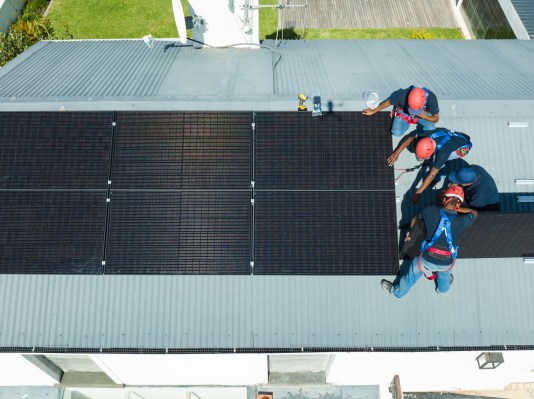There’s been a lot of talk about remaking the electric grid in the U.S. and in Europe, preparing it for a tidal wave of intermittent renewable power and instant-on batteries. It’s happening in fits and starts, with utilities themselves alternately embracing and pushing back against the new, more distributed future. That’s been complicating grid upgrades.
But in places where the grid is unreliable or non-existent, where incumbent resistance doesn’t exist, potential disruptors are popping up. For years, setting up electric grids on islands or in remote territories was a costly proposition since their relatively small sizes ran counter to fossil fuels’ economies of scale. Now, though, renewables are flipping the script.
Yes, even renewables benefit from economies of scale. Scale can be relatively easy to find in places like the U.S., where projects might be large and financing easy to obtain, but in developing countries, it’s all harder to come by. Odyssey Energy Solutions is hoping to change that.
In an exclusive with TechCrunch+, the startup announced today that it has raised $5.34 million in a seed round led by Equal Ventures with Twelve Below, Abstract Ventures, Founder Collective and MCJ Collective participating. The new funds will go toward expanding its platform that enables the planning, financing, building and operating of renewable energy projects in developing economies.
For founder and CEO Emily McAteer, the idea behind Odyssey’s platform was simmering for a few years, starting when she was chief revenue officer for SunEdison’s Frontier Power subsidiary.
“The frictions that I was seeing in trying to develop a large portfolio of assets — there’s really a need for standardization,” she said. Without standardization, investors and developers were struggling to tackle a large enough number of diverse projects to make them financially worthwhile.
“It’s an entirely different paradigm to finance and develop a big portfolio of many small assets versus traditional infrastructure finance, which is a ton of money into a single project. You cannot diligence in the same way. We saw investors trying to fit these portfolios into that mold, and it really wasn’t working,” McAteer said.
One of Odyssey’s overarching goals, she said, is to standardize the way projects are prepared and vetted to streamline the financing process for smaller projects, which in the renewable world would be on the scale of tens or hundreds of millions of dollars. To do so, it’s collecting data on numerous projects to help build a record of how various types will operate, which McAteer said should help build investor confidence. Odyssey also runs an aggregated procurement platform to help bring component prices down for things like solar panels, inverters and so on. The company already has helped draw over $1 billion in financing to distributed renewable energy projects.
Last year, Odyssey added remote monitoring and mini- and microgrid controls to its portfolio with its acquisition of Ferntech, a German startup. It’s a key piece of the puzzle given the distributed nature of renewable energy, one that lets the company more cost-effectively operate and collect data on the projects that are run through its platform.
The word “platform” gets thrown around a lot these days, but Odyssey is indeed operating a true platform, connecting investors with project developers, project developers with suppliers, and communities and businesses with project developers. The thinking is that data and connections from each piece of the platform can inform and add value to the others. Odyssey’s pricing varies, but the company takes a percentage of the transaction for customers that use the platform from end to end.
Currently, the company’s main focus is on developing mini- and microgrids in Africa, though it has projects in more than 50 countries. In the case of microgrids, it might work with a shopping mall operator to provide solar power with battery backup in case the larger grid experiences a blackout or brownout. In the case of minigrids, which are larger, Odyssey works with governments to electrify locales that haven’t yet been connected to the grid.
Already, those grid topologies are starting to fuse into hybrid configurations that start to resemble a regular grid, albeit one that’s bottom-up, rather than the typical top-down approach that’s more common in places like the U.S.
“A market that’s growing in Nigeria is the interconnected minigrid market, which is a collaboration between the distribution company and private minigrid developers,” McAteer said. Grid operators are increasingly turning to minigrid developers to connect swaths of customers, and the two parties then work out arrangements to sell power between each other.
“I think we’re going to start to see a lot more of those hybrid systems where it’s really like, what is the lowest cost? What is the lowest cost system that will give this person power?” she said.
Such federated grids could also help multinational companies solve some of their most intractable carbon emissions, so-called Scope 3 emissions that occur outside their control. It might enable tech companies and EV manufacturers, for example, to finance the development of microgrids at cobalt mines in the Democratic Republic of the Congo so they aren’t reliant on a dirty and unreliable grid, McAteer said.
Given that global power demand is forecast to grow 30% by 2030, according to the International Energy Agency, Odyssey’s potential market is enormous. The market for minigrids, for example, could be worth $220 billion by 2030, according to the World Bank. And if features from minigrids and microgrids end up making their way into the larger grid, the total addressable market could be in the trillions, McAteer said.
“There’s going to be less of a distinction between the off-grid systems and the grid,” she said. The market is so large that it feels infinite at this point, she added. “There’s so much need for distributed renewables.”
